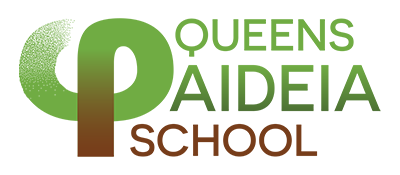Project-based learning (PBL) is an educational experience in which a student engages in a hands-on, sort-of real-life project. These projects promote development of information and skills, transfer of skills, problem solving, collaborative know-how (group PBL), intrinsic motivation, and other benefits. Many parents express great interest in PBL, to the point of there now being schools grounded in its practice. PBL is not a new idea, and there has been so much written about it over the last decade-plus that there is no need to elaborate. What Queens Paideia can do is provide a greater understanding of how PBL fits inside a larger curriculum designed to provide the education that prepares students for a life of continued learning.
Learning Happens Best through Multiple Modalities
First off, QPS staff does not use the phrase project-based learning because of its implication that it is a sufficient method of learning by itself. We regard project work as a step in a broader sequence of learning, so we instead call it application. It is one of three core strands of learning that run through QPS’s curriculum, the other strands being basic skill-building and content knowledge. Depending on their age and stage of development, QPS students build skills like counting, number manipulation, reading, writing, and yes, learning to learn. Skill building is usually interwoven with content knowledge in science, social studies, English language arts, and the arts. But learning and deliberately practicing those basic skills, in a systematic way, are key, because without them, there are serious limits on the types of application that demonstrate what a child has learned and can do.
As students at QPS get older, they continue building skills—math operations and beyond, writing mechanics/style, and note taking, to name a few—but the amount of time spent expanding and using their content knowledge grows larger. In QPS’s middle school years, content knowledge and application are in full flourish, because by this time our students have become confident in their skills and practiced in their use. Their resulting independence as curious and self-motivated learners, with foundational skills and knowledge to back it up, prepares them for high school. They have what they need to take the initiative in their continuing education.
Application Has Its Limits
Most of our students love working on their application projects, but we also know that: (1) many of them enjoy practicing skills and learning about content just as much; (2) application projects tap only some of the skills and content a student has been learning; (3) they can drag on, resulting in opportunity costs re: how a student spends valuable learning time; and (4) students may gravitate to project types that come easily to them, and that reinforce what they already know and can do. All of these factors need to be considered and monitored to yield productive results for our students.
Bottom line: QPS prizes application as a logical extension and demonstration of what our students are doing in their skill building and content acquisition work.
Now for the Cool Stuff
Here are some examples of application projects at Queens Paideia, along with explanations of their underlying skill building and-or content knowledge. It’s a snapshot of what goes on at QPS, and doesn’t include the projects our students undertake at home, because they can and because QPS’s culture encourages it.
 Potential and kinetic energy in play (left). this student applied and furthered his knowledge by storing potential energy in a rubber band and converting it to kinetic energy to propel a car he made using a pattern modified to adjust for friction, wheel size, and overall weight. Identifying and resolving issues around engineering and design involves types of thinking that are key to generalized problem solving.
Potential and kinetic energy in play (left). this student applied and furthered his knowledge by storing potential energy in a rubber band and converting it to kinetic energy to propel a car he made using a pattern modified to adjust for friction, wheel size, and overall weight. Identifying and resolving issues around engineering and design involves types of thinking that are key to generalized problem solving.
Body Biography (right). Creating a life-sized drawing of a character the way he/she is described in the book, including symbolically representing personality traits and supporting them through quotations from the book. The students practice literary analysis to back up which traits to include. Group members discussed the issue and cited textual evidence to support their positions.
Getting charged (left). Is it the size of a battery cell that determines the voltage it can store? The number of cells joined in series? Or a combination of both? Students are using data gathered from different-size lime pieces to inform their design decisions as they build a battery out of another everyday, nontoxic material, with the goal of maximizing voltage. Prior to this, they learned about CO2 emissions and climate change, specifically coal-fired power plants. Renewable energy sources (sun, wind) are not as predictable and controllable as coal, so they are less in demand slow to be adopted. Efficient large-scale battery storage offers promise of the reduction of coal use.
Hands-on projectile motion (right). Students designed and used catapults to fire a clay ball over a Lego wall. They studied kinematic equations of motion and tinkered with the mass of the ball and the angle at which they fired it. The project pulled in concepts of conservation of energy and Newton’s Laws of Motion, which students have studied this year and in previous years.
Machi Koro (left). It sounds a bit like Monopoly, but in this game by a Japanese game designer, there are four landmarks that each player must eventually build in order to win. All of them cost a lot money to build, and a player earns that money by purchasing and making money off of smaller properties along the way. The game demands a constant trade-off between short- and longer-term goals and behaviors. Sounds like life.





